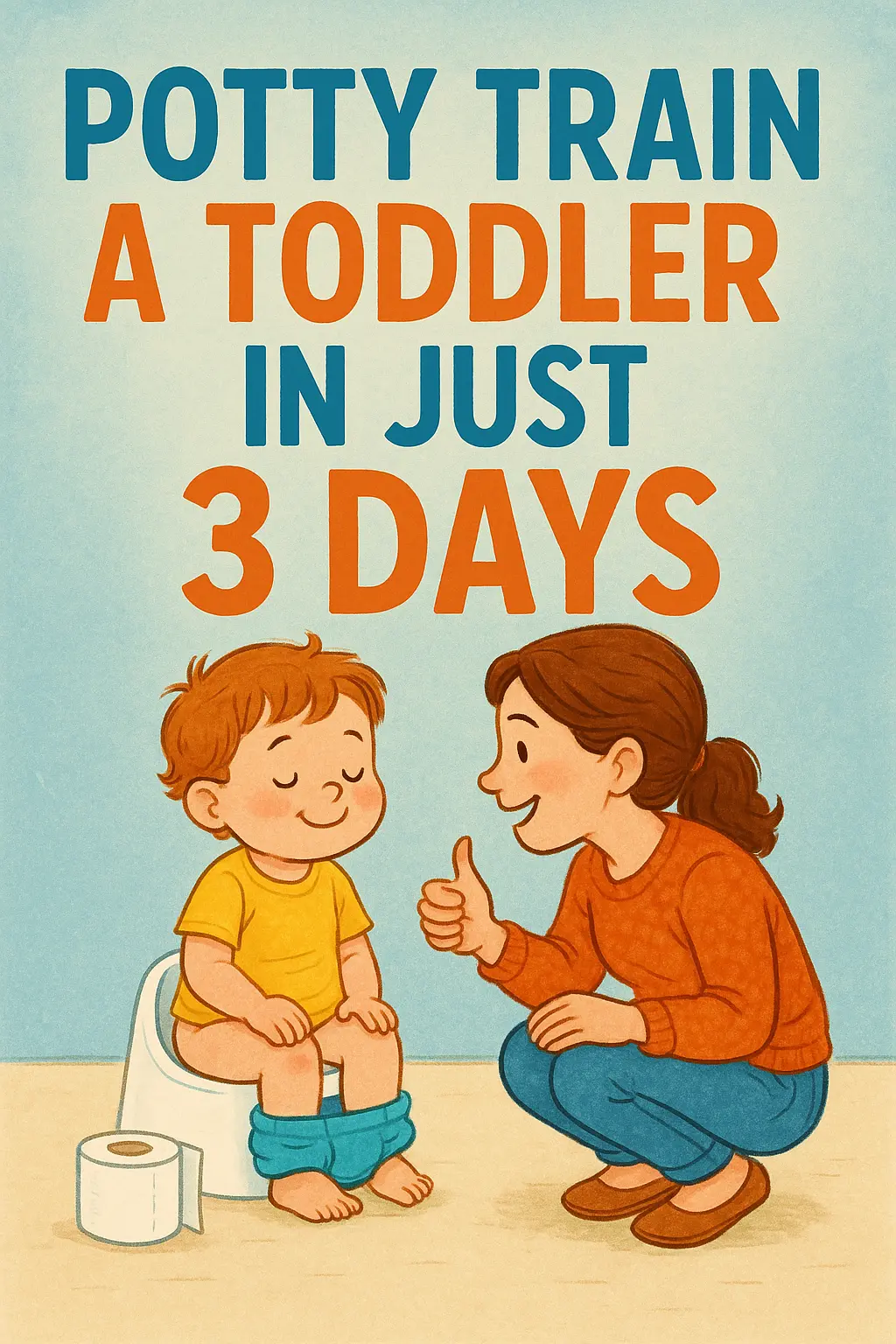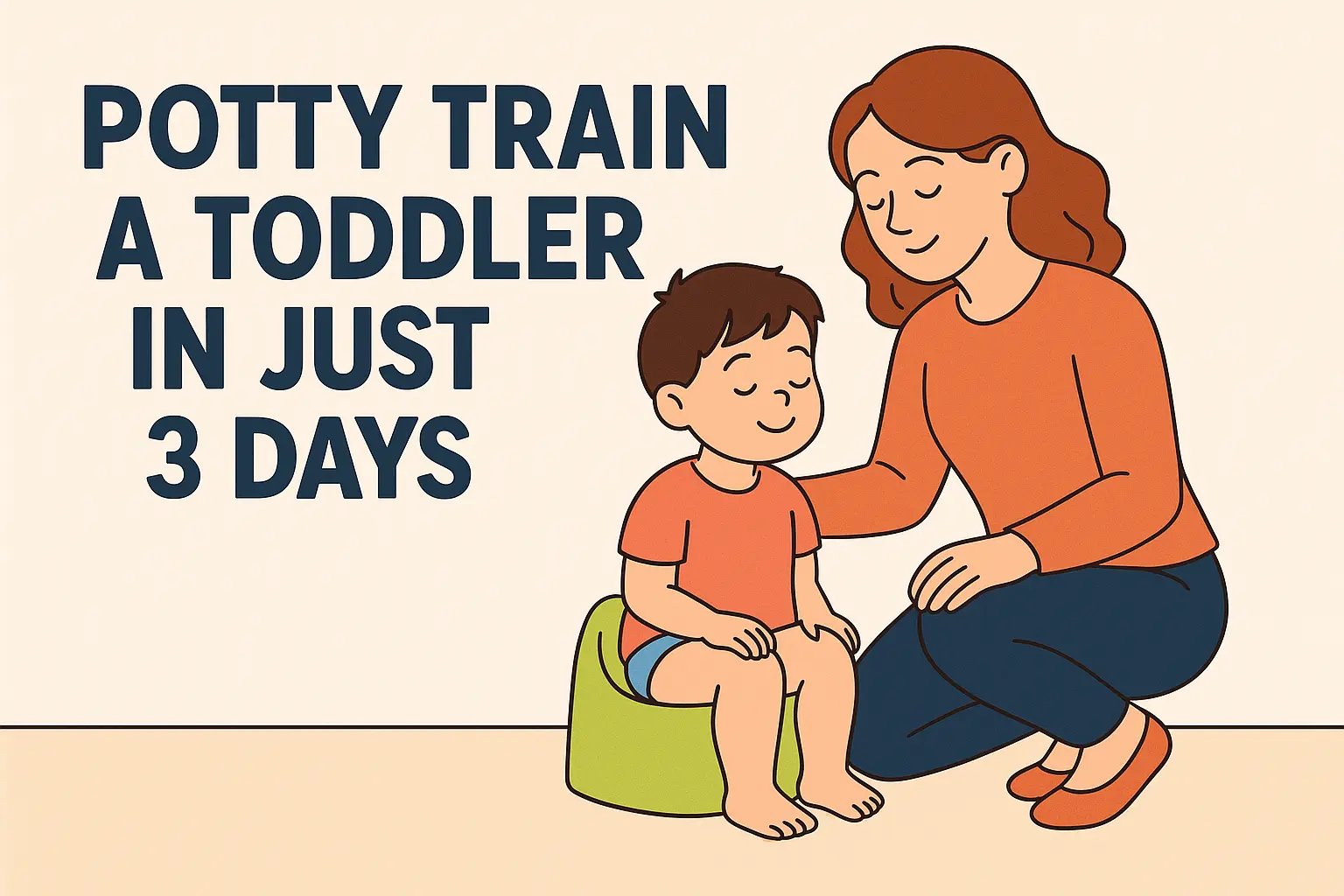Potty training is a significant milestone in toddler development, marking a new stage of growth and parenting adventures. The 3-day potty training method is a focused, diaper-free approach using the bare-bottom method, also known as the pants-free approach, combined with consistent, loving care. This is often chosen for a clean break from diapers and to get your child to make the full transition in a short, focused period. Starting over a long weekend can make it easier for families to dedicate uninterrupted time and attention to training. This method has your child go diaper-free for 3 full days and focuses on positive reinforcement, potty training consistency, and active parenting involvement to help your child transition from diapers to the toilet.
In this guide, you’ll learn about toddler readiness, the step by step 3 day potty training method, common challenges, and advanced tips for long-term success. Whether you’re just starting or looking to refine your approach, these potty training tips will support you on your journey to toilet training success.
Is Your Toddler Ready for Potty Training?
Before you start potty training, you need to know if your toddler is ready. Most children show clear signs of toilet training, such as interest in the bathroom, awareness of bladder control, showing signs of readiness, and can communicate basic needs. Signs of readiness for potty training can start as early as 18 months. Child development experts agree that children develop at their paces, but consistent caregiving and role modeling can encourage independence in toddlers. Knowing when your child is ready, by observing major developmental milestones and behavioral cues, makes potty training smoother.
Look for these key signs of readiness:
- Your toddler shows interest in using the toilet or potty chair.
- They stay dry for longer periods of time.
- They can verbalize the need to go.
- They show tot independence by wanting to dress or undress themselves.
- Parents should look for longer periods between diaper changes as a sign of readiness.
Having the right parenting supplies helps set you up for success. A toddler potty chair or child-size potty makes the transition less scary. Child-friendly underwear and a reward system will encourage good behavior and motivate your child. Let your kids pick their underwear to get them excited about toilet training. Consistent caregiving and patience will give your toddler confidence throughout the process.
Big life changes like the arrival of a new sibling can impact the best time to start potty training, so consider timing carefully.
Preparing for the Transition
Getting ready for potty training is all about setting your child up for success and making the process as smooth as possible. Once you see your child is ready, showing interest in the potty, staying dry for longer periods, or talking about needing to go, it’s time to start potty training with a positive attitude. Start by introducing the idea of using the toilet in a fun, no-pressure way. Read a potty training book together, talk about what to expect, and let your child explore the potty or toilet at their own pace.
A step by step plan will help you stay on track and keep potty training on course. Make sure your child knows accidents are a part of the learning process and always stay calm when they happen. Encourage your child to sit on the potty regularly, especially after meals or when they show signs of needing to go. The more relaxed and supportive you are, the more confident your child will feel about this big change. Every child learns differently, so be patient and celebrate each small win along the way.

The 3-Day Potty Training Method: step by step plan
Day 1 – Introduction & Routine
First, remove the diapers and go bare bottomed to help your toddler learn to recognize bodily cues. For the first 3 days, stay at home to focus and minimize distractions. Don’t have your child wear underwear during this initial phase as not wearing shorts helps them feel bodily sensations and not get confused with diapers.
Keeping a child's bottom dry during the 3 day potty training method helps them pay more attention to their bodily cues and learn when they need to pee. Establish a routine by taking your child to the toilet or potty chair frequently, especially after meals, naps, and waking up. In the morning, have your child use the potty first thing after waking up to help establish a routine.
The goal is for your child to use the potty for pee and poop.
Use positive reinforcement to celebrate attempts and successes. Introduce a simple reward system, like stickers or small treats, to encourage your child. Give your child extra fluids during the 3 day potty training method to get them to use the potty more often. Consistency is key – stay calm and supportive to make the process fun.
Day 2 – Repetition & Confidence
Accidents are part of the learning process. Handle them calmly and use them as teaching opportunities, not punishment. Look for signs of progress even if perfection isn’t immediate. Continue to use positive reinforcement and routine potty visits.
Role modeling is key today. If possible, have an older sibling or parent demonstrate toilet use. Gender specific potty training tips can help make the experience more relatable and less scary for your child.
Day 3 – Encouraging Independence
By day three, encourage your toddler to initiate potty use on their own and support their independence. Praise their efforts and maintain potty training consistency to reinforce new habits. Parents should spend almost all 3 days at home with their child during the 3 day training process. When you start taking short toddler outings, have your child go to the bathroom before you leave the house. Bring a portable potty or find child-friendly toilets to use outside the home. Tell child care providers about your child’s potty training progress and routines so they can be consistent. For example, before leaving a park or store, remind your child to use the toilet so they don’t have an accident.
Celebrate your child’s progress with milestone celebrations and reinforce their success and confidence for continued success.
Nighttime Training: Making the Transition After Dark
Nighttime potty training is a whole different ball game from daytime training, and you need to approach it with patience and realistic expectations. Many kids need more time to stay dry at night, and research shows that most kids achieve nighttime dryness between 5-7 years old. To support your child, start by having them wear underwear or disposable training pants to bed and have them use the potty right before sleep.
Having a consistent bedtime routine that includes a trip to the bathroom can help reinforce the habit of staying dry overnight. Some parents find that using a sticker chart or small rewards motivates their child to stay dry. If your child wets the bed, reassure them that accidents are normal and part of the Training process. Don’t rush or pressure your child; this can lead to frustration for both of you. If you have concerns about your child’s progress with nighttime toilet training, don’t hesitate to reach out to your child’s pediatrician for advice and support. Every child is different, and with time and encouragement, your child will master this.
What to Expect After 3 Days
Potty training maintenance goes beyond the 3 days. Some tots will regress, which is normal during this process. It can take days or even weeks for a child to be fully potty trained even after starting with the 3 day method. Remember not all children will be fully trained right away – look for more success over time as your child gets better. Stay calm and patient and consult your pediatrician if you have persistent issues like accidents or poop problems and helping your child learn to poop in the toilet. Acknowledge your child’s poops as part of their toilet habits and support them through the tough times.
Nighttime dryness takes longer to achieve so continue to use cloth training pants or consider pull ups at night until your child is fully potty trained. Consistency and gradual independence will help your tot master this skill over time.
Common Challenges and How to Solve Them
Toddler accidents, potty training resistance, and tot constipation are common. Accidents will happen during the toilet training process, and you may need to change a diaper if your child wakes up in wet or soiled underwear. Doing regular diaper changes can help your child learn the difference between being wet and dry and support potty training techniques. Manage accidents by staying calm and use accidents as a positive teaching moment.
Address resistance with gentle encouragement and don’t put pressure that can cause setbacks.
If your child gets constipated, increase fluids and see your pediatrician. Watch for pooping cues and praise your child when they poop in the toilet. This will help develop good pooping habits and prevent constipation.
When start teaching hygiene, remind your child to wipe from front to back especially for girls as this will help prevent bringing germs from the rectum to the bladder or vagina and reduce the risk of infections. Consistency and a supportive environment will help your child overcome obstacles and stay motivated.
Help and Support
Potty training can be overwhelming, but you don’t have to do it alone. If you’re having challenges or concerns about your child’s potty training process, reach out for help. Your child’s pediatrician can offer guidance, address any medical concerns, and help you find a potty training method that works for your child.
There are many resources for parents, from potty training books and online articles to support groups where you can connect with other families going through the same thing. Many parents have found success with structured approaches like the 3 day potty training method, which includes frequent potty trips, positive reinforcement, and a gradual move to underwear. Remember, every child is different, and what works for one may not work for another. Be flexible, keep an open mind, and don’t hesitate to ask for help when you need it.
Bonus Tips for Long-Term Potty Training Success
Monitor your toddler’s fluids to reduce nighttime accidents and support bladder control. Celebrate every success.
Support gradual independence by having your child dress themselves in big kid underwear and use the toilet with minimal help. Add a step stool and a child-friendly bathroom setup to make it easier and more comfortable. Teach hygiene like wiping from front to back during potty training.
Many parents have found the 3 day potty training method worked for their family. Rest assured all advice here is content accurate, based on expert recommendations and current research.
Conclusion and Next Steps
Potty training is a big deal for both you and your child, and you need to approach it with patience, encouragement, and a clear step by step plan. Celebrate every little bit of progress, from staying dry for a few hours to using the potty independently, and remember accidents happen as part of the Training process. Stay calm and supportive, and your child will gain confidence and become completely potty trained. If you need more help, reach out to your child’s pediatrician or check out the American Academy of Pediatrics or the Mayo Clinic. With time, patience, and a smile, your child will get the potty and love being a big kid.
FAQS
What is 3-day potty training method?
This accelerated potty training technique involves intense potty training for three consecutive days, achieving a seamless transition from diaper to underwear by encouraging a frequent potty trips.
What are the signs to know if my toddler is ready for potty training?
If your toddler is ready to communicate for needs, has discomfort with diapers, and has prolonged dry periods, then you can start potty training your toddler.
What if my toddler doesn’t achieve success in a three-day potty training method?
If your toddler fails to achieve potty training success in 3-days, assess your child and be patient and positive with a break before trying it again. All toddlers may not adapt to the trip's approach, so opt for a gradual one.
Is there any success tip for making a three-day potty training session successful?
Patience, dedication, positivity, reinforcement, consistency, and a very relaxed approach are a the must. Giving small rewards, developing a routine, and ensuring the comfortless of your toddler can elevate the process.













